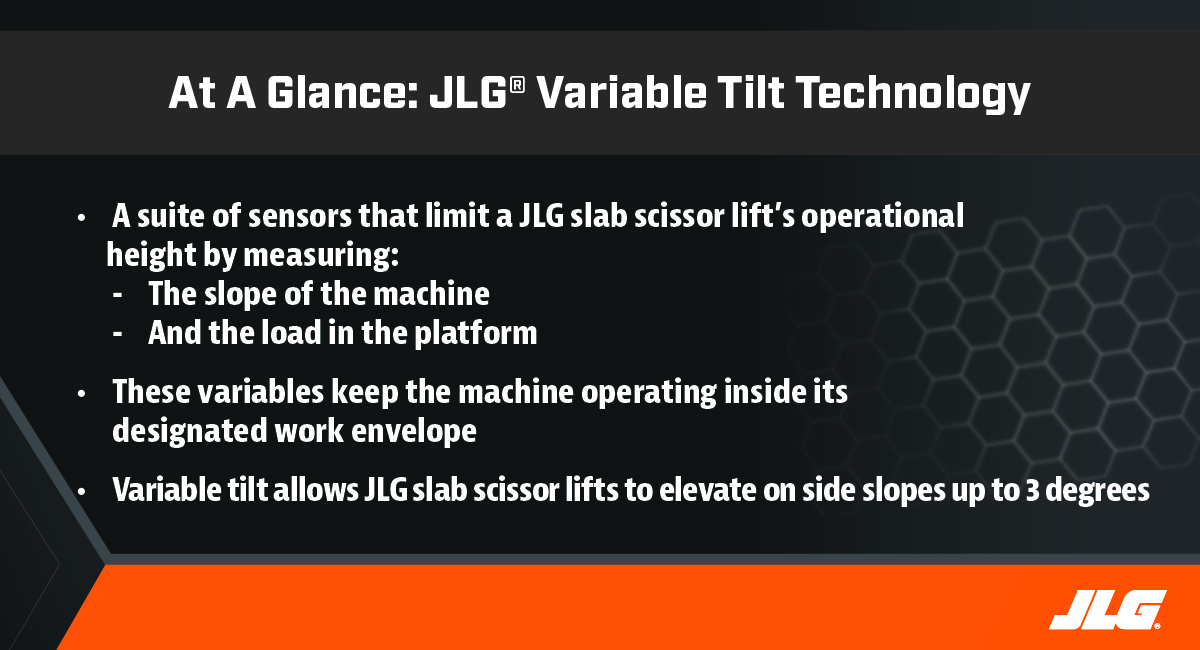 Bob Begley
Bob Begley
Director - Product Management
____
JLG Industries
Each JLG® slab scissor lift is equipped with sensors that detect the slope the machine is on. These sensors limit the lifts maximum deck elevation to ensure it stays within its work envelope. But, many fleet owners and operators may not fully understand how variable tilt technology works.

JLG’s variable tilt technology utilizes a suite of sensors that measure the slope of the machine and the load in the platform to control its max operational height. When the machine is in use, its load sensing system continuously monitors load and slope. This data is sent to the machine’s control system where it is assessed against the appropriate indoor or outdoor lift chart to set the maximum height at which the machine can safely be used.
The operational data related to max height is displayed to the operator through the LCD display, which indicates how high the platform can be raised based on current conditions. This gives the operator the option to reduce the load in the platform or reposition the machine on a more level surface.
On typical scissor lifts, if the machine is working on a slope greater than 1.5 degrees, the lift would not be able to elevate. JLG’s exclusive variable tilt technology allows its slab scissor lifts to elevate on side slopes up to 3 degrees, giving the operator a greater degree of flexibility. Most importantly, continuous monitoring by the sensors keeps machines operating within the approved work envelope.
Let’s take a closer look at two common scenarios where JLG’s variable tilt technology helps operators work more efficiently at height.
Scenario #1 – Food Processing Plant
Jim is a maintenance technician at a meatpacking plant in Chicago. This morning, he needs to diagnose what’s wrong with an overhead conveyor that carries large cuts of meat from the slaughterhouse to the packing area.
His first step is to diagnose where the failure occurred. To help him reach the conveyor, which varies in height from 10- to 15-ft above the plant floor, he maneuvers a JLG ES1932 scissor lift next to it to begin his inspection process.
The concrete floor in this area was laid with a 2-degree slope to enable easy wash-down and drainage. As Jim prepares to elevate the scissor lift, he realizes that he must check the slope gauge on the instrument panel. Two of the three lights are illuminated, which means that the maximum platform height will be limited.
Jim consults the machine’s operation and safety manual and learns that the maximum deck height will be 14-ft — just enough to comfortably reach and inspect the broken conveyor. He connects his fall restraint harness to the machine’s anchor point, elevates the work platform and gets to work, confident that the ES1932’s variable tilt system will keep him operating within the machine’s approved work envelope.
Jim is happy that his employer replaced its old scissor lift, which automatically cut out as soon as the ground slope exceeded 1.5 degrees. The JLG machine lets him get more done with fewer operational interruptions.
Because the floor has a consistent slope, Jim can drive the ES1932 along the conveyor, checking idlers and drive motors as he goes. After several stops, he finds the problem.
Scenario #2 – Data Center
Carl is a contractor installing network cabling at a new data center in Salt Lake City. It utilizes a network of raised trays to carry data cables above the floor of the massive facility. His job is to lay the cables and connect them so that data can flow smoothly through servers, routers and other high-tech equipment.
Today, he’s utilizing a rented JLG ES2632 scissor lift to start on this project. He maneuvers it next to one of the reinforced concrete walls of the data center and positions it just below and in front of an empty aluminum cable tray.
He recalls hearing from his supervisor that the floor in this part of the building was built with approximately 1 degree of slope. He glances at the machine’s LCD slope indicator. It shows that the platform can be fully extended to its maximum height of just over 25-ft.
He carefully positions the machine, connects his fall restraint harness to an anchor point and elevates the scissor lift until he’s alongside the cable tray. Knowing that the ES2632 was designed to work on side-to-side slopes of up to 3 degrees, gives him peace of mind. He grabs his toolbox and a spool of CAT5 cable from the floor of the work platform and gets to work.
Improving Productivity
New machine technologies like variable tilt offer not only safety enhancements, but also extend the versatility of access equipment across changing ground conditions for improved productivity. For example, when operators know how much material they can take up with them, more or less than what they already have loaded before raising the machine, it removes the guesswork that often results in operators having to descend and try again.
Technological advancements like this continue to transform the access industry. To learn more about how JLG’s variable tilt technology works, click here.
Do you want to stay up to date with industry news and issues similar to this? Make sure you subscribe below to receive monthly updates from #DirectAccess with newly posted content so you never miss important information.